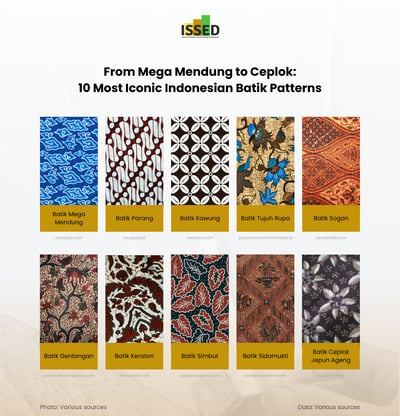From Mega Mendung to Ceplok: 10 Most Iconic Indonesian Batik Patterns
INFOGRAPHICS
10/2/2024
Every October 2, Indonesians celebrate National Batik Day by wearing various batik patterns throughout the day. This commemoration celebrates when Batik was officially acknowledged as a part of the Masterpieces of the Oral and Intangible Heritage of Humanity on October 2, 2009 by UNESCO. This recognition marks the importance of batik as a symbol of Indonesia's rich and diverse culture. According to our search results, some of the most iconic and popular batik motifs include Batik Mega Mendung, Parang, Kawung, Tujuh Rupa, Sogan, Gentongan, Keraton, Simbut, Sidomukti, and Ceplok Jepun Ageng. Each of these motifs has a deep philosophy that depicts the beauty and cultural richness of various regions in Indonesia. Each variety of shape and color has a distinctive philosophical and aesthetic meaning, making it an invaluable heritage.
As the times change, batik making continues to transform, not only with traditional techniques such as writing with canting or making a stamp from wax, but also integrated with modern technologies such as machine learning datasets to detect and classify batik motifs. For example, there are several datasets developed specifically for machine learning and computer vision purposes, such as Batik 300, which is a collection of 300 images of 50 types of batik, each taken from up to six random angles and resized to 128x128 pixels. There is also Batik Nitik Sarimbit 120, which contains 120 batik motifs, each paired with a similar motif, and can be used to train machine learning algorithms and generate new batik motifs. In addition, Batik Nitik 960 consists of 960 batik images in 60 categories that can be used for classification, image retrieval, and generative adversarial network development.
Despite the speed and complexity of this new technology, these developments have also led to controversies regarding authenticity and the possible diminution of cultural value if too much reliance is placed on technology. One of the main concerns is that the use of modern technology, such as machine learning and artificial intelligence, could replace the manual skills of traditional artisans. The manual making of batik, especially hand-drawn batik, involves a long and meticulous process, where each pattern and motif detail has a deep philosophy that is passed down from generation to generation.
Meanwhile, it cannot be denied that technology does enable faster and more efficient batik production, especially to meet the high market demand. One example of a product that integrates technology in batik making is the Batik Fractal software (www.batikfractal.com). Interestingly, the brand still works with traditional batik artisans for the handmade batik production process. The difference is they use the help of modern technology to create new designs inspired by beautiful cultural diversity. Since 2007, they have networked with more than 3000 artisans across Indonesia.
These days, there are rising concerns that the batik process will become too mechanized and lose its spiritual and philosophical value. For example, motifs such as Mega Mendung or Parang that have certain symbolism, such as hope or strength, may no longer be understood in the same way when generated through algorithms or digital prints. In this context, batik is not just about beautiful patterns or images, but also about the process of making it that involves tradition, folklore and rich local knowledge. This debate reflects the challenges in the modern era, where the preservation of traditional culture must balance between technological innovation and maintaining the essence of the art that has been passed down through generations. More importantly, let’s continue to preserve and appreciate the beauty of batik as one of Indonesia's cultural masterpieces!


